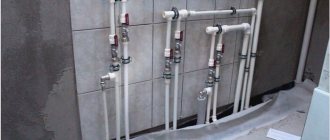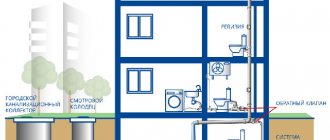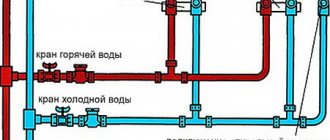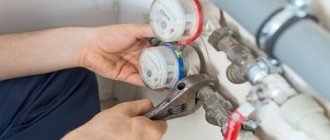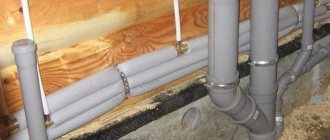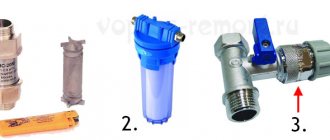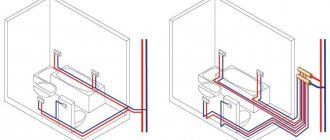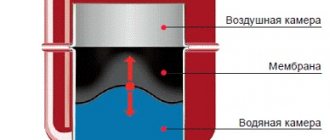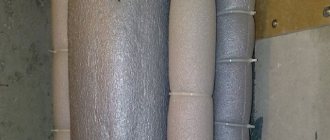One of the important steps towards saving budget funds on heating is organizing heat energy metering. Accounting for resources such as gas, water and electricity has long been commonplace for most consumers. At the same time, the majority thought that it was impossible to bring heat under this line, so installing heating meters in the apartment became a kind of innovation for them. How to properly install a heat meter? Let's figure it out.
Heating meters in an apartment: profitable or not
In accordance with Federal Law No. 261, ODPU must be installed in apartment buildings that are connected to central communications. The presence of a common device allows owners of apartments and non-residential premises to equip their objects with individual reading devices.
To switch to accounting according to IPU, owners must install heat meters. The installation is provided for by the payment calculation procedure, which is enshrined in Government Decree No. 354.
Checking and removing indicators from the IPU
Since meters are not required to be installed by employees of the management company or housing office, residents can apply for registration to these companies or other independent organizations that have licenses for such activities. Also, these actions can be aimed at checking and taking readings.
A citizen can record the taking of testimony if the quality of service provision is low. Then he has the right to apply to the utility service and request a recalculation. At the time of submitting the document, the device must be installed and registered within the framework of the law.
Residents have the right to both register a meter and remove it by submitting an appropriate application. In case of illegal actions or inactions of authorized persons, citizens can file a complaint with the management or directly to the court.
Is it possible to save money with a heat meter? Watch this video:
See also Phone numbers for consultation January 31, 2021 Victoria M. 565
Share this post
How to install an individual heat meter
The installation procedure for the IPU is not complicated if the steps are followed according to the step-by-step instructions:
- Installation of heat meters begins with a general meeting of owners of apartment buildings. Owners of apartments and non-residential premises must come to the decision that the house will be equipped with flow meters 100%.
- Coordination is being carried out with the resource supplying organization. The procedure will allow you to select a suitable model of the mechanism and determine a list of processes that must be performed in advance. The fewest problems arise in houses in which the wiring is arranged horizontally.
- It is recommended to assess the condition of the system in advance, on the basis of which it is easier to obtain installation specifications.
- Additionally, it is advisable for each owner to take care of increasing the energy efficiency of the living space: insulation is carried out, and places of possible heat leakage are eliminated.
- A project is being drawn up. An official commercial organization is involved, which is empowered to provide specific services. It is more profitable to carry out general door-to-door work, which will allow you to save significantly.
- Technical documentation is coordinated with the heat supply organization. Depending on the form of management of an apartment building, the involvement of a management company may be required.
- A company that will install the meter is selected and a contract is concluded. For everything to be legal, the chosen company must have permission to carry out the work. In some cases, it is more effective to invite a supplying organization.
- After installation, an application is submitted to the utility service provider to put the device into operation, which is accompanied by sealing and issuance of the corresponding certificate.
Coordination and installation of heat meters in apartment buildings is a lengthy process, and besides, the savings from such devices do not always justify the costs of them
If all work is carried out by the resource supplier or management company, difficulties can be avoided, because the contractor most often provides a full range of paid and free services.
With horizontal wiring of the heating system, an individual meter is most often installed outside the apartment in a special box. If you wish to move the mechanism indoors, you must obtain a separate permit.
Recommendations for choosing a device and its installation
To correctly account for the low flow rate of coolant used to heat an apartment, 2 types of household heat meters are used:
- mechanical (otherwise known as tachometer);
- ultrasonic.
Note. The technical parameters of commercial metering devices are determined by design engineers based on calculations.
This is what tachometer heat metering devices look like.
To understand the difference between them and make the right choice, you need to understand a little how a heat meter works. It consists of three main elements that perform their functions:
- A flow meter whose task is to determine the amount of water flowing through a pipe section per unit of time. It crashes into the supply pipeline.
- Forward and reverse flow temperature sensors (resistance thermal converters).
- Electronic computer block. Receiving signals from sensors and a flow meter, the device calculates the consumed heat using the formula included in the program. The result is reflected on the display and can be transmitted to the supplier via GSM connection or the Internet.
Types of heat meters differ in the design of the flow meter. In tachometer models, this is an impeller immersed in the flowing coolant. In the second type, the amount of water is measured using ultrasound passing through the stream. The latest devices are more reliable and unpretentious in terms of coolant quality, although the price is 15-20% more expensive.
Ultrasonic heat meters designed for installation in apartments
Important point. When issuing technical specifications, heat supply organizations strongly recommend installing ultrasonic heat meters in apartments. The reason is not only reliability and durability. Unscrupulous tenants are just thinking about how to deceive any meters, including heat meters (for example, stop them using magnets). The operating principle of the ultrasonic device does not allow the readings to be influenced illegally.
Clip-on heat meter from the famous European brand Danfoss
It is impossible not to mention another type of heat consumption analyzer - clip-on devices installed directly on the battery (so-called proportionalizers). They determine energy consumption by the temperature of the heat-releasing surface and the air in the room; you just need to enter the technical parameters of the radiator into the device’s memory in advance.
Proportionalizers are widely used in Western Europe, but in the post-Soviet space they are not yet in demand due to inconsistency in legislation. However, large cities have already gained some experience in the successful use of such heat meters, as described in the video:
As mentioned earlier, the installation of a thermal energy meter is carried out by personnel of a licensed company. You can only monitor their operation, knowing that the flow meter is installed on the supply pipeline, and the sensors are embedded in the supply and return lines. Moreover, in new models there is only one sensor - for the return line, and the supply temperature meter is built into the flow meter housing.
As a rule, modern heat meters do not require compliance with measuring sections (straight pipes of a certain length before and after the device).
The nuances of installing heat meters in an apartment with vertical wiring
The scheme is implemented in many old multi-storey buildings and causes certain difficulties when placing metering devices. Several risers are installed into the room, to which separate radiators are connected.
At the moment, most domestic apartment buildings have a vertical heating distribution system, which makes it much more difficult to obtain permission and install individual heat meters
The installation of heat meters on batteries in apartments with central heating and vertical wiring is prohibited. The taboo is recorded in Order No. 627, officially approved by the Ministry of Regional Development.
The current regulatory act does not limit consumers in their right to install devices that will take into account the consumption of utility resources. There are rules:
- An exception to Order No. 627 is made for apartment buildings that are subject to amendments to Federal Law No. 261-FZ.
- If, according to the design characteristics of the engineering heating system, it is not possible to place a meter, heat consumption indicators, called flow meters, are used for accounting.
The second option provides that a special device will be installed separately on each battery, the work of which is to analyze the heat in the room and the temperature of the radiator. The procedure for calculating monthly payments in 2021 is carried out on the basis of RF PP No. 354.
Do not confuse the meter embedded in the heating system with a proportionator or regulator, because the meter takes into account the temperature in the entire system, the proportionator takes data only on one radiator, and the regulator does not count anything at all, it sets the temperature
General information
There are hidden heating fees. From the boiler room, the medium enters the central heating system at a high temperature. Poor insulation does not bring the initial heat to the apartment. Residents who have not installed meters on their heating pipes have to pay for heat loss.
Types of heating network wiring
There are two types of apartment wiring: vertical or horizontal. Until the beginning of the twenty-first century, only vertical wiring was done in high-rise buildings.
Vertical type of wiring
Vertical wiring involves the implementation of a heating system with one or two pipes. The coolant is sequentially driven through it through all floors from top to bottom and vice versa. The method is considered economical because a minimum of pipes are required during installation.
Attention! In Khrushchev-era buildings, vertical-type heating pipes are common.
The circuit of this system covers many floors with apartments. It is not possible to install a mortise counter on it.
The vertical type of pipe laying has disadvantages:
1.heat is distributed unevenly.
2.It is difficult to regulate the degree of heating of the battery.
3.it is difficult to balance the system.
4.It is difficult to achieve individual metering of heat consumption.
Horizontal wiring method
With a horizontal type of wiring, the coolant is distributed from one vertical type riser to apartments. For the other riser, as a return pipeline, the circuit is located in the technical shaft near the main supply circuit. Pipes running horizontally from two risers into each room are responsible for the supply and return flow of the coolant. The cooled water enters the return pipeline, flowing into the heating station or into the boiler.
Attention! The disadvantage of this type of wiring is its high cost.
Advantages of the horizontal type:
1.adjustment of the carrier temperature indicator in the system in all apartments.
2. the ability to carry out repairs on a separate section without affecting the entire highway.
3.Heating starts quickly throughout the house.
4. You can easily install a heat meter in your apartment.
Types of meters
The devices are suitable for pipes with a cross-section of up to twenty millimeters in diameter, with a coolant load on the circuits of 0.6 - 2.5 cubic meters per hour. The amount of heat consumed is calculated automatically, the numbers are shown on the display. Specifies the period for which the calculation should be made. It could be an hour, or a month, or a day. The data is stored in the device’s memory for one to three years.
Attention! A convenient installation option is a non-volatile heating meter powered by a battery.
Heat meters display information about consumption in kilowatts, gigajoules, gigacalories. Utilities charge per gigacalorie. Therefore, you will have to use formulas for recalculation. If kilowatts per hour, then multiply the readings by the number 0.0008598.
Meters may include several devices in a set. For example, temperature sensors, meters of the amount of heat energy spent, pressure sensors. The installation of the device is carried out at the final stage of installation work on laying the heating system in the apartment. The principle of heat energy metering affects which flow meter is installed on the meter: ultrasonic, mechanical.
There are devices with an electromagnetic type of flow meter, or a vortex type. These varieties are practically not used because they are used for laying heating pipes horizontally.
A separate group of devices includes distributors and heat consumption calculators; they require insertion into the heating pipe. These devices can be used in any type of wiring.
Is it beneficial to have it in the MKD?
Apartment heat meters allow you to control heating fees.
The temperature in the apartment can be adjusted independently. Before leaving home, residents can lower the temperature in the apartment or completely turn off the heating during their departure, and at the end of the month they can feel the savings. According to experts, apartment meters can save you up to 2 rubles per month. True, savings depend on the quality of home insulation. On average, installing a meter and the cost of the device itself will cost about 20,000 rubles.
If the house has good insulation, the IPU will pay for itself in about a year. If the apartment has large rooms and they are heated independently of each other, the apartment meter will be unprofitable. In addition, you need to take into account the heating system in the house. The devices are usually mounted directly on the coolant supply pipe; if the heating system is standing, you will have to install a separate meter on each pipe, which is quite expensive. With a horizontal system, one meter is installed.
Classification and principle of operation of heat meters
The priority principle of operation of all similar products for metering thermal energy is readings at a certain water temperature.
Any heat accrual device consists of three components:
- Sensor;
- Unit for distribution, pressure and fluid resistance;
- Device for metering received thermal energy.
Scheme of the operating principle of a common house heat meter
In addition, meters are divided by purpose. They are available for individual and industrial (household) use.
Devices for houses with autonomous heating and apartments differ from house ones in more precise adjustment.
Heat energy metering devices for home use are divided into several types:
- Mechanical;
- Electromagnetic;
- Ultrasonic;
- Vortex devices.
To better understand their fundamental work, let’s look at each variety in more detail.
Tachometer instruments
The most affordable and understandable from the point of view of the average person are mechanical devices. Such devices use a rotating drum in the form of a small turbine as a meter.
Tachometer heat meter
It rotates from the pressure of the coolant, thanks to which water consumption is recorded. Typically, tachometer meters are equipped with two flow meters (on the inlet and outlet pipes), a resistance element and a heat calculator.
Sometimes devices are provided with pressure sensors. Such meters must have filters installed at the entrance. If the equipment is put into operation without them, then the presence of mechanical impurities (particles of sand, gravel, rust) will affect the operation of the device, and it will produce distorted readings.
Electromagnetic devices
This device's operating principle is based on the manifestation of electromagnetic induction. Inside the product there are several magnets that create a field of the same name.
Electromagnetic heat meter
As you know, water is a good conductor and when it passes through a magnetic field, an electric current is generated. Moreover, its value is directly proportional to the speed of fluid flow.
The generated electric current enters the computing node. And since the difference in current values is small, such devices require proper installation and special operating conditions.
Data readings will be distorted if the device is connected in violation of the required level (vertical instead of horizontal heating distribution in a high-rise building). And also at the junction there should not be a narrower throughput channel.
And one more factor that influences the reliability of information for coolants of this type is that the presence of iron in any form (scale, rust) is excluded in the water.
Ultrasonic heat metering
Meters with ultrasonic radiation are characterized by an unusual operating principle and high cost. The originality lies in measuring the passage of a wave through a liquid, depending on the speed of the coolant.
Ultrasonic heat meter
In other words, the flow rate is calculated by the time it takes for the signal to arrive from the radiation source to the receiver. In these products, strict placement of devices on the same line is important.
Vortex heat accounting
Turbulent-type devices are distinguished by a special measurement. In the path of the coolant in the pipeline there is a prism, which is an obstacle, and a vortex flow occurs.
Vortex heat meter
The number of vortex branches is recorded by special sensors and flow meters, which are located at a certain distance from the prism. And the stronger the flow speed, the greater the number of vortices formed.
Legal installation procedure
Heat meters can be installed only after agreement with the management company, and for this there is a certain procedure, after which installation will be possible.
Therefore, the following steps should be followed:
| First you need to contact the house management company in writing. | Which can give permission to install the meter, and copies of documents are attached to the application. They must confirm ownership of the apartment, as well as the registration certificate of the apartment |
| Next, the company provides technical specifications | Which must be observed when installing the meter |
| The next step implies that an individual heat metering project is being developed | And technical documents for the installation are being drawn up, this is the task of the organization that has officially received design authority |
| Documents made | Coordinated with the company supplying heat |
There is no need to buy an energy meter before the project has been agreed upon, since the application may well be rejected.
Having all the documents, you can make a purchase by choosing any heat meters for heating in the apartment that comply with established standards.
Be sure to take from the seller both cash receipts and sales receipts, operating instructions, warranty card and, of course, a copy of the certificate of the appropriate level of quality.
When choosing a company that will carry out installation, you should make sure that it has a license for such activities, and you can even make a comparison, focusing on certificates, the Unified State Register of Legal Entities and SRO approvals.
In addition, it is also advisable to check the qualifications of the installers in advance; you should take into account the list of equipment they use, the list of the work they perform and whether they have an installation kit.
Guarantees must be given for the work if the management company does not accept the results or has comments.
In addition to the meter itself, it is also necessary to ensure the presence of additional devices, for example a bypass, thermostats and filters for pipes and radiators, tees and all other necessary technical devices.
Also, the equipment must be sealed on a mandatory basis and the initial readings recorded; this is done upon the call of a representative of the company - the heat supplier.
Video: principle of operation
Checking heat meters
Typically, new devices are sold with an initial test, which is carried out at the factory that produces them. Proof that the verification of heat meters has been carried out is the presence of a special sticker corresponding to the entry, a special mark, both on the devices and in the documents attached to them. During operation, verification of heating meters is carried out at the expense of apartment owners once every 4 years; to carry it out, you must contact a number of organizations and institutions:
- to the Rostest department;
- to a company that has the appropriate authority to carry out the inspection;
- to the service center of the manufacturer.
They independently take readings from the heating meter in the same way as from the electric meter. The payment receipt indicates the difference in readings, multiplies it by the established tariff and makes the payment, for example, in one of the Sberbank branches. The recipient of the payment is the heat supply organization.
Heat meters - installation advantages, detailed video:
Advantages of using an apartment heat meter
If you decide to install a heat meter in your home, you must remember that this device itself will not give any result in terms of savings, but - within reason, of course - it will provide an opportunity to save on heating, demonstrating the current use of resources. You will soon see for yourself that this will have a positive impact on utility costs.
Note! The meter allows you to control energy consumption only when the temperature is controlled by a thermostat and the unit itself is designed correctly.
And if you lower the temperature every time you go to work, then at the end of the month you will be convinced that the purchase is worthwhile. So, according to preliminary calculations, the savings will be about 6 percent. It should also be remembered that the procedure for installing the meter itself is quite complicated - this will require the collection of appropriate documentation, and unforeseen expenses are also possible (we will tell you in more detail about the documents and installation a little later).
Product selection criteria
When choosing a thermal product, you need to focus not only on the cost and advertising description, but also on the operation of heat meters. However, they must meet the following characteristics:
- Water measurement range;
- Hydraulic losses after installation of the device. The diameter of the channel behind the meter should not be less than that before the device;
- Saving money. The cost of the product and all components required for installation;
- The prevalence of this device in the region of residence, reviews about it;
- Service of the selected counter.
Types of heat metering devices
Important. Without the appropriate certificate for the device, the management company will not take the product into operation, so when purchasing, be sure to request this document from the distributor.
In addition to the above parameters, such indicators of devices as the coolant inlet circuit and the working fluid itself are important for specialists, and they also need to know the limit values of the existing parameters for this coolant.
An important factor when choosing a device to be installed in an apartment is the model and cost of the selected product:
Heat meters - what are they, what can they be?
Meters are devices for measuring heat in an apartment. The operation of the heat meter is based on the principle of calculating the amount of heat using data taken from the coolant flow sensor and temperature sensors. The amount of water that has passed through the heating system is measured, as well as the temperature difference at the inlet and outlet. Metering devices can be common and individual.
Common house buildings (ODPU)
A common building meter measures the amount of heat consumed in the entire apartment building. Responsibility for the accuracy of the meter readings lies with the management company or homeowners association (HOA), or resource supply organization. In some old houses, it is impossible to install metering devices for technical reasons; there, heat consumption is calculated based on the area of housing, standards for thermal energy and tariffs for them.
If there is a general building meter, the cost of heating is calculated based on the amount of energy consumed by all residents of the apartment building, and the payment for the apartment is calculated taking into account its area.
Individual (IPU)
Individual metering devices are installed in order to pay based on the heat consumed in a particular apartment. In this case, residents pay for heat supply according to the readings of their apartment meter, and not according to the standard and, in principle, can save on heating costs.
Individual metering devices do not cancel fees for general household needs. Owners of apartments with self-employed housing are required to pay for heating their entrances.
Mechanical heat meters
Mechanical (or tachometer) heat energy meters shown in the photo are simple units. They usually include a heat meter and a rotary water meter. The principle of how this type of heating meter works is as follows: for convenience and accuracy of measurement, the translational movement of the coolant liquid turns into a rotational one.
A mechanical (tachometer) meter is a very economical purchase, but the cost of filters should be added to its price. As a result, the kit will cost the consumer about 15% less than other types of heat meters, but provided that the pipeline diameter does not exceed 32 millimeters.
Mechanical devices have a significant drawback - they cannot be used when the coolant (water) has a high degree of hardness and if it contains particles of rust, scale or scale, since they clog filters and flow meters.



